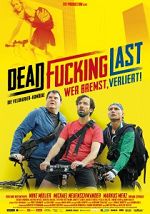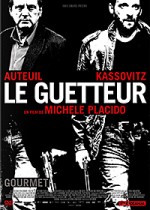The Making-of 2012
Case Studies
Overview
| Case studies | High Budget | “Standard” budget |
|---|---|---|
| Title (country) | Le Guetteur/The Lookout (FR/BE/IT) | Dead Fucking Last (CH) |
| Director | Michele Placido (IT) | Walter Feistle (CH) |
| Presented by | Post-Production Supervisor: Riccardo Marchegiani | Producer: Kaspar Winkler |
| Production company | Babe Films (FR) | Tilt Production Gmbh (CH) |
| Postproduction provider | Digimage Cinéma, Tommaso Vergallo | Swiss Effects Film GmbH, Ruedi Schick |
| Budget approx.in Euro | 14.000.000€ | 1.300.000€ |
| Camera(s) | ARRI Alexa Codex RAW, ARRI Alexa Plus (ARRI RAW), RED Epic, RED One Camera (some shots) | Main camera: ARRI Alexa Additional cameras: GoPro, Canon EOS MARK III 7D |
| Post-production/Colour correction in | 4K (film negative format) | 2K |
| Film Format / projection | CinemaScope (cinematographic process), 2.35:1 (aspect ratio), 35mm &D-Cinema (printed film format) | 1:1,85 (for the takes) 1:2.35 Cinemascope (film format) 2K DCP (delivery format) |

Case Study 1 : Dead Fucking Last by Walter Feistle, presented by its producer, Kaspar Winkler, and its post-production provider Ruedi Schick, Swiss Effects Film GmbH
Focus on shooting with ARRI, ProRes.
Introduction:
First of all, it is important to note that this special title is in fact very adapted to the story being told since DFL is a slang word used by the bike messengers, the key characters of the film.
At the very first Digital Production Challenge Seminar, taking place 2009 in Zurich, the film was pitched by the producer as follows:
A feature film
Title: DIE GENOSSENSCHAFT (THE COOPERATIVE)
Budget: 1.8 Million Euro (today’s exchange rate)
30 Days of Shooting
A lot of action – but also a film with a lot of dialogues
The main producer’s questions were:
- Do we shoot with a digital or an analog camera?
- If analogue: Which format: Super16 or 35mm – 2perf?
- If digital: With which camera?
What today – 3 years later – sounds a bit funny, was then a real question, because a lot of TV-movies were still shot in Super 16.
DPC experts recommended to shoot with a digital SI-2K camera. As additional camera, they suggested a Canon EOS MARK III 7D.
In 2011, two years later, the realisation of the project:
As often in this industry, things change significantly and quickly: many developments have happened during the financing and shooting period of the film.
These were the parameters before shooting:
A feature film
Title: DEAD FUCKING LAST
Budget: 1.3 Million Euro
23 Days of shooting
A lot of creative action – but also a film with a lot of dialogues.
Main Camera: ARRI ALEXA Raw recording
Additional Cameras: GO-PRO for about 5 minutes of the film, Canon EOS MARK III 7D (finely 10 Seconds of the Film) & Sony Ex3 (finally 3 seconds of the film).
The main challenges of the film:
a. The budget
This was the first, important challenge since the originally planned budget could not be raised. There was a lack of 500'000 Euro; nevertheless, the producers, director and the main staff members decided to start the shooting being confident solutions could be found to cut costs on some specific budget lines (such as on equipment - cameras). They developed a special action plan. Their credo was: “Do it yourself, do it now, do it without“.
The main changes vs. the original plan were:
- a reduced crew of 22 persons;
- a reduced shooting period: from 30 to 23 days;
- the shoot took place in existing locations;
- reduced technical equipment, the main advantage for the crew was to be very flexible and to adapt quickly to shooting schedule changes and shooting conditions;
- a very collaborative experience: all the crew members tried to find creative and cost-conscious solutions for their department. They called it the Producing Method.
b. Camera Equipment and Crew
It has been decided to go for digital cameras, others than those suggested at the DPC Workshop in Zurich, but in a similar way.
The crew worked out the following technical concept:
- Hand camera – no dolly – no crane;
- Only 3 people for the Camera department: Cameraman, Camera assistant, DIT;
- The choice of the ARRI ALEXA as main camera. It is very sensitive to the light, even shots taken by low light are of a very high quality;
- Only 2 people in the electric department: a chief electrician and 1 assistant;
- Electrical equipment amounting to only 8’000 Euro
These were the challenges the camera crew was confronted with:
- Most of the takes were shot with the camera lens wide open;
- Very short focus range;
- Because of the hand camera and the high shooting pace, the camera often moved intuitively. For the camera assistant, this meant to react intuitively too, to keep the picture in focus.
- The weight of the Arri Alexa is enormous, even with the steady for the arms. Fortunately enough, Felix von Muralt (cameraman) was well-trained.
The importance of the Team Work:
Only the well-rehearsed team-play between camera crew and electrician, a constant communication between staff members, especially between the key crew positions and the producer, and a special commitment of the crew members made it possible!
- Felix von Muralt (cameraman) was able to take the lack of technical equipment as a chance to develop a particular aesthetics.
- Stefan Stefanini (the camera assistant) brought his immense experience and skills to achieve wonders.
- The DIT, Ben Hagen, not only saved the data – a very important job! – but he was also a key crew member in the whole process (pre, prod, post) who kept on brainstorming to find the most efficient solutions to the main challenges faced by the crew.
At first, the producer was not sure to hire a DIT. But, very quickly it appeared essential to do so, based on the evolution of the shooting conditions and financial means. The possibility to have a look at the dailies on the set and at every shot taken did help the creative process significantly.
Results for the project:
- A quick and flexible shooting;
- Very short setting of light (on an average, there were 25 takes per day);
- The hand camera has given a kind of breathing to the film, it has been a real, creative element;
c. SFX (for action scenes)
As it was decided not to use cranes, dollies etc., the crew had to find other ways to shoot action scenes or scenes with a high demand for movement. They chose using GoPro cameras. These cameras are very common in the amateur Outdoor scene to shoot action.
This section of the case study was strongly supported by film clips to concretely explain the challenges faced and solutions found:
First clip: Alleycat-race (at the very beginning of the film):
That day, they shot 100% GoPro, 10 cameras. The aim was to catch the race as lively as possible. The cameraman gave the order of the day: Shoot as badly as possible!
Some cameras were fixed on the bikes, others were hand-held.
The GoPros have a wide-angle-lens. Therefore, it was impossible to make close-ups. The crew took this constraint as a creative challenge: instead of hiding it as good as possible, they decided to reinforce the look of it in the colour grading.
They ended by having a huge mass of material. It was a lot of work for the cutter and his assistant to sort it out.
Second clip(water scene):
The underwater camera was a GoPro.
The cameraman also jumped with the stuntmen into the water, thus shooting with a GoPro. But these shots couldn’t be used because of the extreme wide-angle.
In order to shoot people swimming, it is necessary to do this with the camera as close to the water’s surface as possible. Because the film crew couldn’t use the special boat the Zurich Lake Police owns, the cameraman and his assistant constructed a frame, with ties and stands, which allowed them to hold the Arri Alexa only five centimetres over the surface.
Other cameras were used: the Canon EOS MARK III 7D and Sony EX3 for point-of-view shots out of cars or for the TV camera, announcing the club opening.
But, only very little of this material was used in the final editing of the film: GoPro about 5 Minutes, Canon EOS MARK III 7D (10 Seconds of the Film) & Sony EX3 (3 Seconds of the film).
Main Conclusion
Despite the heavy weight of the Arri Alexa, this camera has a wide range of possibilities and even on low budget films, it can often turned to be the most cost effective choice as well as the most creative one. This camera turned to have important comfort and adaptation capacities but it is key to select a DoP who knows this camera well in order to use its potential at its maximum.

Case Study 2 — Le Guetteur by Michele Placido, presented by its post-production supervisor, Riccardo Marchegiani,and its post-production provider Tommaso Vergallo, Digimage Cinéma.
Focus on Mixed Raw shooting with on-set dailies.
This is a high budget film (originally estimated at 16 Mo Euro but the cost has been reduced to 14Mo Euro), co-produced between France, Belgium and Italy. This is a thriller, action film. A 10-week shoot.
At first, the workflow was designed to have the final look on set. Pre-grading has been done on set with Meta Data (to save time at the end of the chain), there have been 2 post-production workflows because this is a film with lots of cuts.
Rushes were dealt with after shoot by the post-production provider, Digimage.
The workflow chosen was designed on speed but this architecture was not the best for the film. There have been lots of slow motion and a mix of cameras:
| Cameras A and B | Arriflex Alexa Plus |
|---|---|
| Camera C | RED MX for Varispeed shoots |
| Camera D | RED Epic |
One of the main challenges of the film has been the storage: 11GB/minute ARRI RAW, 100’/day, 1TB needed per day, 50TB in total. 2 copies on set, each HD named as: Master or Back-Up + day number. Each back-up was sent to Digimage at the end of the day to be copied on LTO tapes.
Precautions: 2TB HDs (HD 25% empty for insurance), Recording ProRes on SxS.
On the film, there were both one DIT and one Data Manager.
The naming of the files proved to be very complex and a nightmare for the Data Manager to find his way with the huge number of tapes. Clearly the structure of the storage was not adapted.
Besides, there have been conformation issues (image) mostly due to communication problems during this period.
There were LUTs (Look Up Tables) on set. It was thus possible to see dailies on the set with the LUT chosen by the DIT. Transcoding for AVID in DNX36.Back-up on-line (LUT + 1DPX SMPTE 12 bit + 1 IMG JPEG).
Once edited (a 20-week work), the film turned to be different from had been seen on the set, the film was blue and cold. The director was not satisfied and he changed his mind regarding the look of the film (especially the change of colour).
The Making-of 2012
- General Presentation
- Summary
- Case Studies
- Technical Presentations [PDF] by P. Ros
- Participants’ Projects
- Workflows of Participants’ Projects [PDF] by P. Ros
- The DCI Manufacturing Process and Digital Cinema Distribution
- Digital Distribution in France
- Digitisation and Archiving (summary, separate detailed presentations)
- Photo Gallery